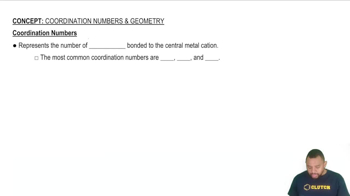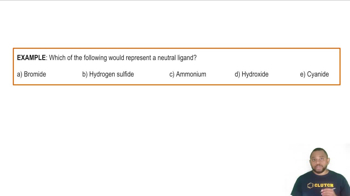Here are the essential concepts you must grasp in order to answer the question correctly.
Coordination Number
The coordination number refers to the number of ligand atoms that are directly bonded to a central metal atom in a coordination complex. It is a crucial concept in coordination chemistry, as it helps determine the geometry and stability of the complex. For example, a coordination number of 4 typically leads to a tetrahedral or square planar geometry.
Recommended video:
Ligands
Ligands are ions or molecules that can donate a pair of electrons to a central metal atom, forming coordinate covalent bonds. They can be classified as monodentate (binding through one atom) or polydentate (binding through multiple atoms). Understanding the nature of ligands is essential for determining the coordination number and the overall structure of the complex.
Recommended video:
Oxidation State
The oxidation state of a metal in a coordination complex indicates the charge of the metal ion when it is part of the compound. It is important for understanding the electronic configuration and reactivity of the metal. The oxidation state can influence the coordination number, as different oxidation states can stabilize different numbers of ligands around the metal.
Recommended video:
 Verified step by step guidance
Verified step by step guidance


